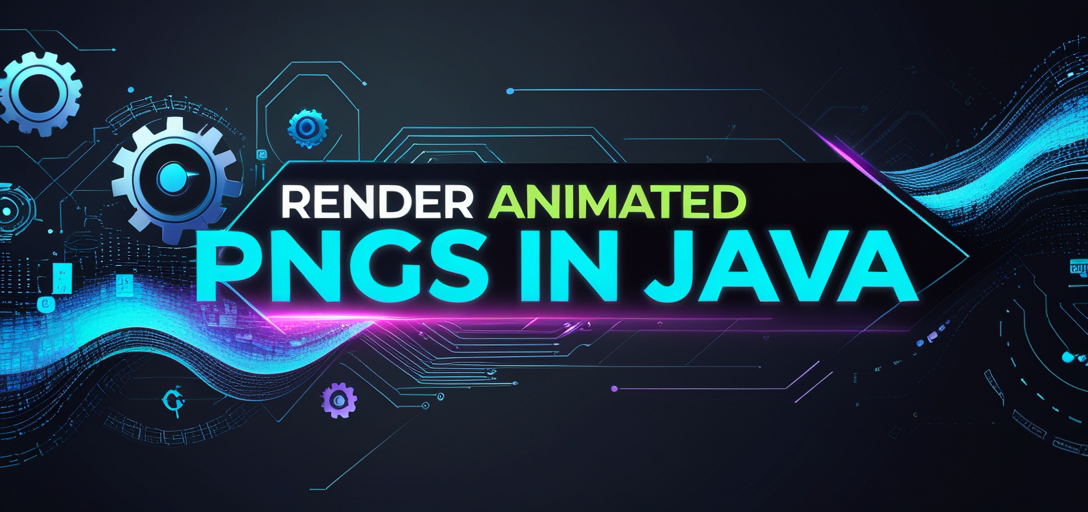How to Render Animated PNGs with GroupDocs.Viewer in Java
Discover the process of transforming Animated PNG (APNG) files into various formats like HTML, JPG, PNG, and PDF using the powerful GroupDocs.Viewer for Java library.
Introduction
Displaying animated images on websites or applications can be challenging. APNGs are perfect for rich graphics, but converting them across platforms requires a robust solution. GroupDocs.Viewer for Java simplifies rendering these animations into multiple formats seamlessly.

In this tutorial, you’ll learn how to use GroupDocs.Viewer to:
- Render APNG files as embedded HTML documents.
- Convert each APNG frame into separate JPG images.
- Transform APNG frames into individual PNG files.
- Compile an entire APNG into a single PDF document.
By the end, you’ll be equipped with the skills needed to integrate these functionalities into your Java applications effectively.
Prerequisites
Before starting with GroupDocs.Viewer for Java, ensure you have:
- Java Development Kit (JDK): JDK 8 or higher is required.
- Maven: Understanding Maven helps in managing dependencies efficiently.
- APNG File: An APNG file should be ready in your project directory.
Setting Up GroupDocs.Viewer for Java
To begin, set up GroupDocs.Viewer in your project. Follow these steps:
Maven Configuration
Add the following dependency to your pom.xml:
<repositories>
<repository>
<id>groupdocs-repo</id>
<name>GroupDocs Repository</name>
<url>https://releases.groupdocs.com/viewer/java/</url>
</repository>
</repositories>
<dependencies>
<dependency>
<groupId>com.groupdocs</groupId>
<artifactId>groupdocs-viewer</artifactId>
<version>25.2</version>
</dependency>
</dependencies>
License Acquisition
To try GroupDocs.Viewer, you can:
- Download a Trial: Get the trial version from GroupDocs website.
- Obtain a Temporary License: Explore full functionalities with a temporary license.
- Purchase: Consider buying if you find it useful for your projects.
Basic Initialization
Create a new Java project, include the Maven setup above, and import necessary packages:
import com.groupdocs.viewer.Viewer;
import com.groupdocs.viewer.options.*;
Implementation Guide
Explore how to implement various rendering features using GroupDocs.Viewer.
Rendering Animated PNG to HTML
Overview: Embed an APNG file into an HTML document with all resources embedded for easy web display.
Step-by-Step Implementation:
Set Up Paths
Define paths for output and input directories:
Path outputDirectory = Paths.get("YOUR_OUTPUT_DIRECTORY"); Path pageFilePathFormat = outputDirectory.resolve("apng_result.html");Initialize Viewer
Create a
Viewerinstance pointing to your APNG file:try (Viewer viewer = new Viewer("YOUR_DOCUMENT_DIRECTORY/SAMPLE_APNG")) { HtmlViewOptions options = HtmlViewOptions.forEmbeddedResources(pageFilePathFormat); // Render the APNG into HTML with embedded resources. viewer.view(options); }Explanation
HtmlViewOptions.forEmbeddedResources: Embeds all necessary resources within the HTML file for independent viewing.
Rendering Animated PNG to JPG
Overview: Convert each frame of an APNG into individual JPG files.
Step-by-Step Implementation:
Configure Paths
Path outputDirectory = Paths.get("YOUR_OUTPUT_DIRECTORY"); Path pageFilePathFormat = outputDirectory.resolve("apng_result_{0}.jpg");Render to JPG
try (Viewer viewer = new Viewer("YOUR_DOCUMENT_DIRECTORY/SAMPLE_APNG")) { JpgViewOptions options = new JpgViewOptions(pageFilePathFormat); // Each frame becomes a separate JPG image. viewer.view(options); }Explanation
JpgViewOptions: Creates a JPG file for each APNG frame, ideal for static representations.
Rendering Animated PNG to PNG
Overview: Create individual PNG files from APNG frames.
Step-by-Step Implementation:
Set Output Paths
Path outputDirectory = Paths.get("YOUR_OUTPUT_DIRECTORY"); Path pageFilePathFormat = outputDirectory.resolve("apng_result_{0}.png");Execute Rendering
try (Viewer viewer = new Viewer("YOUR_DOCUMENT_DIRECTORY/SAMPLE_APNG")) { PngViewOptions options = new PngViewOptions(pageFilePathFormat); // Converts each frame to a separate PNG. viewer.view(options); }Explanation
PngViewOptions: Maintains original image quality, suitable for lossless conversions.
Rendering Animated PNG to PDF
Overview: Compile an entire APNG into a single PDF document.
Step-by-Step Implementation:
Define Paths
Path outputDirectory = Paths.get("YOUR_OUTPUT_DIRECTORY"); Path pageFilePathFormat = outputDirectory.resolve("apng_result.pdf");Render to PDF
try (Viewer viewer = new Viewer("YOUR_DOCUMENT_DIRECTORY/SAMPLE_APNG")) { PdfViewOptions options = new PdfViewOptions(pageFilePathFormat); // Convert the APNG into a single PDF. viewer.view(options); }Explanation
PdfViewOptions: Consolidates frames into one document, perfect for print-ready formats.
Practical Applications
Here are some real-world scenarios where these features can be applied:
- Web Development: Embed APNGs in web pages without losing animation quality.
- Digital Publishing: Create interactive PDFs with animated content.
- Marketing Materials: Generate high-quality static images from animations for brochures and banners.
- Data Visualization: Display animated graphs or charts in both digital and printed formats.
Performance Considerations
To ensure optimal performance when using GroupDocs.Viewer:
- Optimize Image Sizes: Pre-process your APNG files to reduce file sizes before rendering.
- Resource Management: Use try-with-resources for automatic resource management, preventing memory leaks.
- Batch Processing: For large batches of images, consider processing in chunks rather than all at once.
Conclusion
You now have the knowledge to use GroupDocs.Viewer for Java to render APNG files into various formats efficiently. Whether you’re developing web applications or creating digital publications, these techniques will enhance your projects’ visual appeal and functionality.
As next steps, explore further capabilities of GroupDocs.Viewer by checking out the official documentation and experimenting with different file types.
FAQ Section
Q1: Can I render other image formats using GroupDocs.Viewer? A1: Yes, GroupDocs.Viewer supports various formats including JPEG, PNG, PDF, and more.
Q2: Is there a limit to the number of frames in an APNG that can be rendered? A2: While there is no hard limit, performance may degrade with very high frame counts. Optimize your images for better results.
Q3: How do I handle exceptions during rendering? A3: Use try-catch blocks around your rendering code to manage potential errors gracefully.
Q4: Can I customize the output quality of rendered files?
A4: Yes, you can adjust settings within JpgViewOptions and other options for desired output quality.
Q5: What are some common issues with APNG rendering? A5: Issues may include incorrect frame timing or resource embedding errors. Ensure your APNGs are correctly formatted.